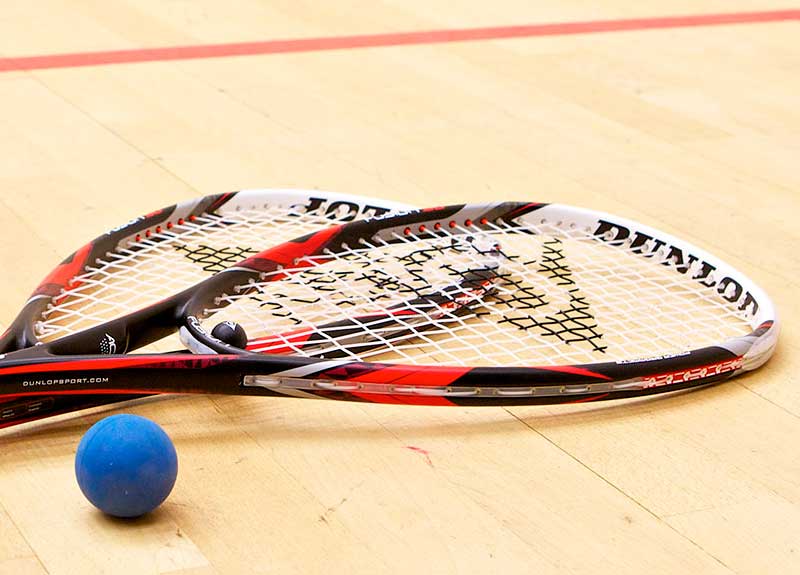To enjoy a squash game, every player needs three essential elements. In the guide below, you will find all the necessary information concerning squash equipment.
The racket
This one is the extension of your arm, and therefore an essential part of your equipment! Even if some will give importance to the aesthetics, the grip is the essential aspect: we often hear professional players say, “Today, I felt my racket well”. There are concrete features to differentiate them, but playability is probably the most important criterion when choosing. In other words, even if a particular racquet doesn’t match your playing style on paper, the most important thing is that you feel comfortable with it on the court. Since the products on sale today are developed directly with professional players based on their needs, quality is bound to be a factor.
Other features of a squash racket:
- Cost – a beginner player will be looking at an entry level racquet, such as the Prince Pro Airstick 550, before moving on to products that are more suited to their playing style.
- Weight – most current models weigh between 130-150g (not including strings and extra protection around the frame).
- Frame shape – with a racket core, such as the Dunlop Precision Elite – used for many, many years by number one players, or a teardrop shape. This is the case with most of the models from Eye Rackets, including “Superman” Paul Coll’s V-Lite 115 Control. This type of racquet has a smaller head size and is, therefore, less tolerant of off-centre hits. More experienced players tend to gravitate towards these as they are more maneuverable.
- Frame Profile – Some squash racquets have a thicker frame, which impacts stiffness and power output when hitting (e.g. Victor racquets). In contrast, the Tecnifibre Carboflex 125 X Speed, used by world number one and world champion Mohamed El Shorbagy, has a very thin profile that allows for easier racquet head acceleration.
- Balance – there are three types of racquets: handle weighted, balanced and head weighted. This is something that everyone has to define personally. In the past, most professional players favoured head-heavy racquets, but as the game has evolved (becoming faster and more aggressive), they are turning to slightly more balanced racquets.
Shoes
When you go to a squash club, you are usually told that you must use shoes with non-marking soles. Squash is a fast-paced sport, and having the right shoes is another essential part of the game. Choosing the right shoe size is of course the most important criteria. As with the racket, the feel of the shoe is important, but there are other features to consider:
- Cost – a beginner player will choose entry-level shoes, such as the Adidas Game Court, before moving on to slightly more premium products if they increase their frequency of practice. Eye Rackets, which offer a wide range of colours, have become very popular with professional players in recent months.
- Cushioning – the ability of the shoe to absorb ground impact.
- Weight – shoes should be comfortable and robust without being too heavy. Avoid shoes that are too light, as they will not withstand the many lateral movements involved in squash.
- Ventilation – necessary to allow perspiration to escape and avoid the feeling of dampness.
- Support – squash shoes on the market have many technologies that support the foot.
Another important point: how often should you replace your shoes? If you play twice a week, we recommend that you change your shoes twice during the season. Worn-out shoes will not only affect the quality of your movement but will also increase the risk of injury.
The ball
You have your squash shoes on and your racquet in hand. Unless you’ve decided to ghost, all you need is a ball! Here are the different types (in the case of Dunlop, the market leader and partner of the Professional Squash Association), from the fastest to the slowest, and with a bounce adapted to the level of practice:
- Red point or Progress – beginners or players who want to perfect their technique.
- Blue Point or Intro – intermediate players. Wider than the classic squash ball, and with a higher bounce.
- 1 yellow point or Competition – intermediate and advanced players.
- 2 yellow points or Pro – balls used in national and international competitions.
The temperature of the room affects the dynamic of the ball, and therefore your game. Squash players often use the expression “warming up the ball,” because at the beginning of a session it is “cold” and does not bounce much. As it hits the walls, its temperature increases and it becomes more dynamic. This is why professional players – with greater speed and power – take much less time to heat up a ball. So don’t hesitate to change the type of ball to get the best quality of play: a slower ball in a high temperature because the ambient heat will increase its dynamism and a faster ball in a cold room.

